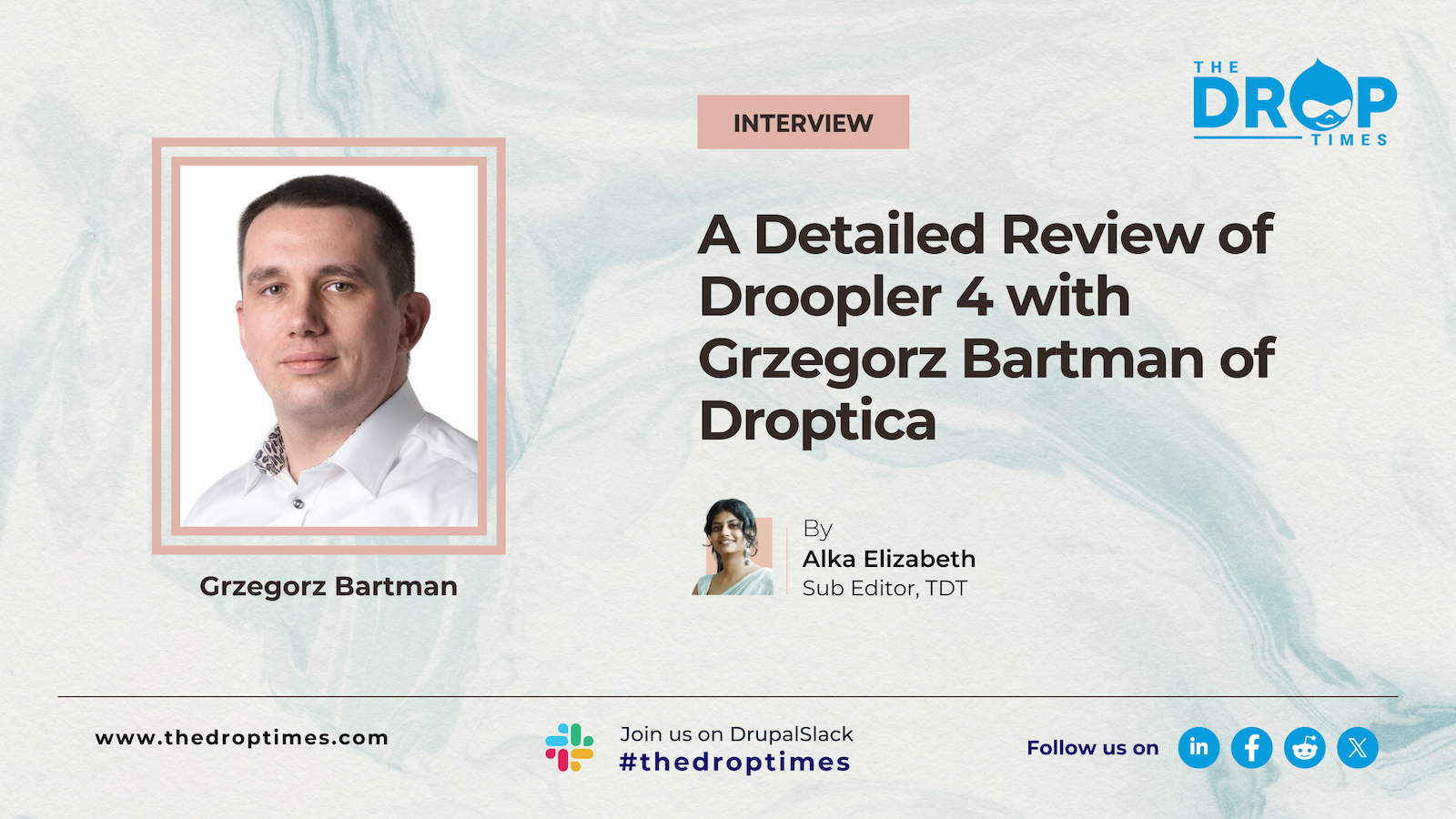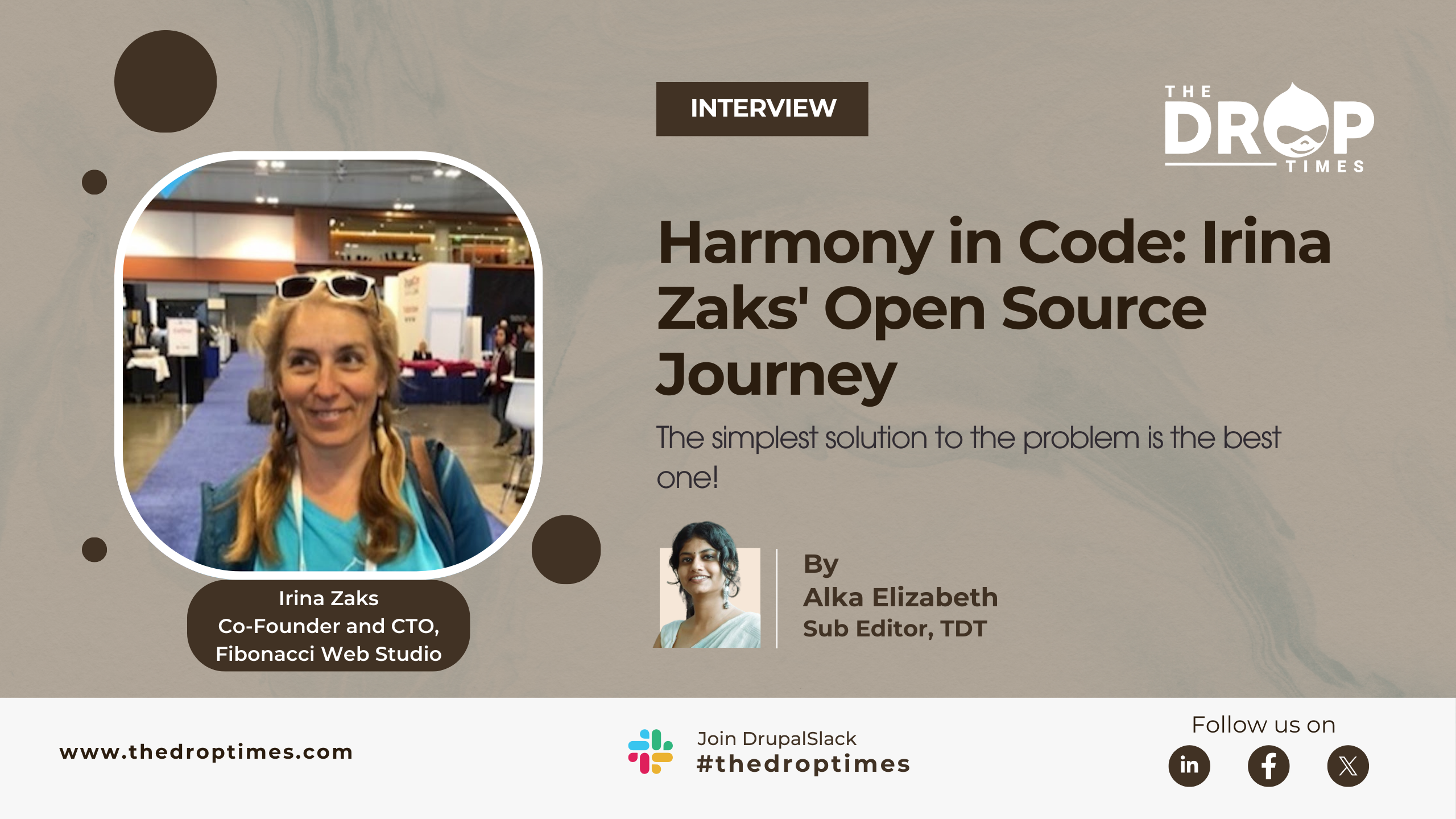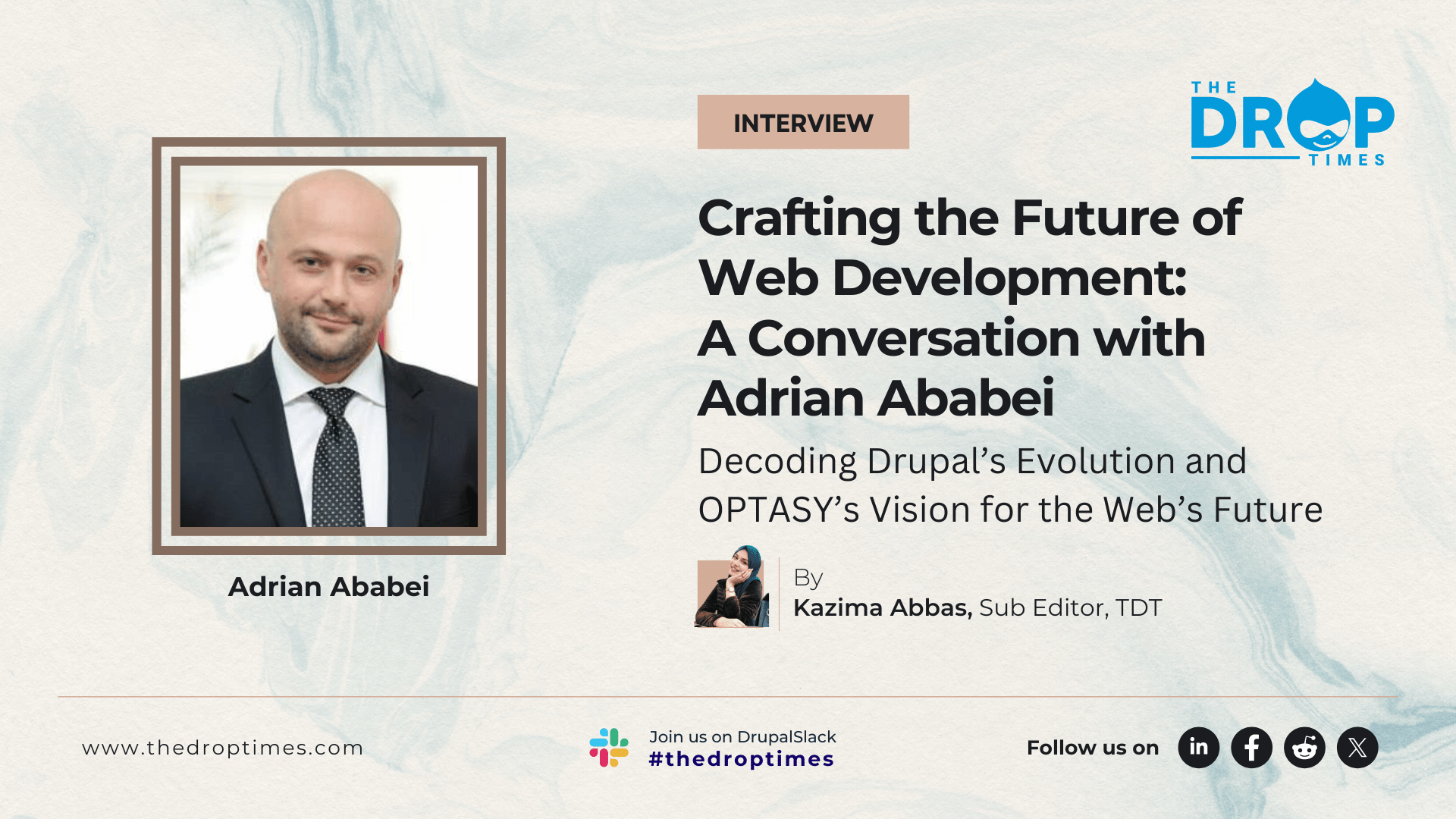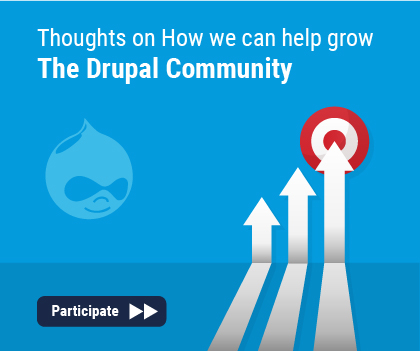Drupal Best Suited for DXPs, Not for Brochure Websites: Jurriaan Roelofs
Jurriaan Roelofs is the founder and senior product manager of DXPR, a company known for its SaaS offering with which one could build Drupal websites without knowing how to code. Drupal layout builder offered by DXPR is unique in the Drupalasque landscape and is believed to make Drupal a popular choice even for medium and small companies with lesser go-to-market window, minuscule budget for marketers, and little time to hunt for developers.
As part of our effort to feature products and distributions around Drupal, TheDropTimes (TDT) reached out to Jurriaan and arranged an email interview with him. Our Editor-in-Chief, Sebin A. Jacob, shot several questions on behalf of the larger community, and Jurriaan painstakingly replied to them. Here is the result:

TDT [1]: How did you first become introduced to Drupal, and what inspired you to build Drupal themes and work with the platform?
Jurriaan Roelofs: “That’s a funny story. At the time, I was doing some freelance web design work and building websites for fun. I was using Mambo (now known as Joomla) and was intrigued by the trend of using CSS to build layouts instead of tables and spacer GIFs. This CSS gallery site called ‘CSS Zen Garden’ published submissions—webpages built with CSS. They looked amazing. What people achieved with simple CSS was groundbreaking at the time, and I was so inspired.
Working with Mambo, I was annoyed that the entire CMS was built with table layouts. I was so inspired that I spent an entire summer replacing all the table layouts inside the CMS with CSS-powered layouts. I was so excited to share it with the community. I knew nothing about contributing or version control systems back then, so I just zipped the whole CMS and attached it to a forum post.
At the time, I was surprised that no one responded to my post, but today I realize that no one was going to take the trouble to review my code if I just uploaded a zip file. After this ‘summer of code,’ I discovered Drupal, and it did everything that Mambo did but better, and it was already based on CSS layouts. I enjoyed working with CSS, so I built Drupal themes based on free HTML or Photoshop templates next to my freelance web design work. I distributed those on alldrupalthemes.com. Later, I added paid Drupal themes and paid my way through college with the themes.”
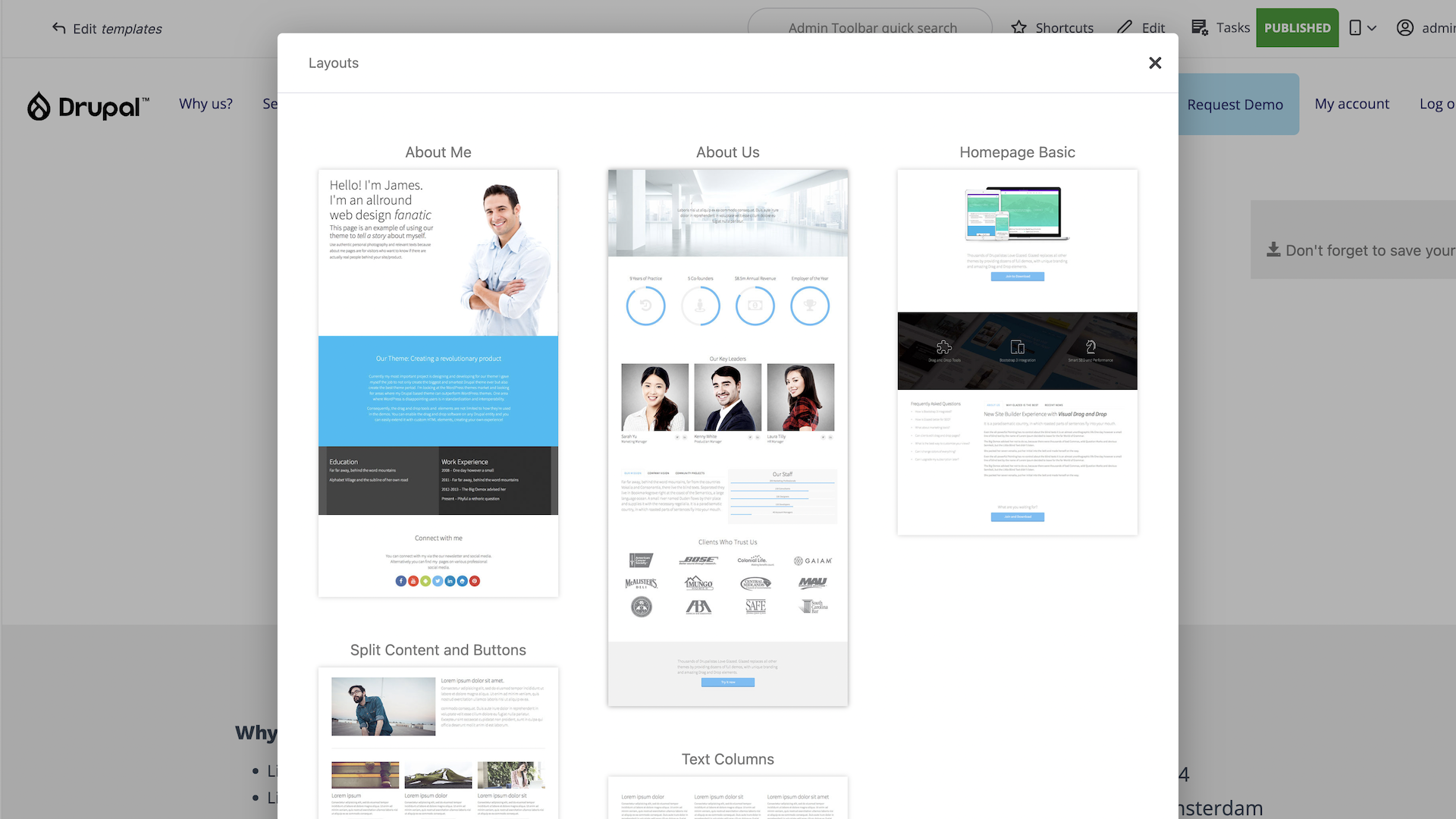
TDT [2]: You maintain 47 modules in Drupal and are credited for 28 fixed issues starting from December 2015. It might inspire the community if you shed some light on your contributions. What is your most significant contribution to Drupal?
Jurriaan: The most significant contribution would be the DXPR theme. We used to sell this "premium theme," and it was our core business. The entire industry of selling themes collapsed about ten years ago, so we decided to completely open source and demonetize it. Most Drupal theme shops have gone out of business since then. DXPR is still in business because we pivoted into developing a better user experience for content editors with drag-and-drop technology.
TDT [3]: How did you develop the idea for DXPR, and what was your motivation for starting the company?
Jurriaan: About 8 years ago, drag-and-drop page builders were available for WordPress, but not for Drupal. As a web designer, I was intrigued by software that automates part of my job, so I began exploring the possibilities of improving my own web design and development workflow with drag-and-drop software. I started by developing my own set of tools.
As with the themes, I found that I really enjoyed working on this, and other people were also interested in this. At that time, I had given my theme shop a rest and was working on other things while playing with drag-and-drop technology. After spending enough time with the tools, I decided to integrate the drag-and-drop software with the DXPR theme and completely replace the "shortcodes" modules with drag-and-drop capabilities. We started selling the drag-and-drop builder along with the premium themes.

TDT [4]: Can you describe the objectives of DXPR and how it helps marketers and businesses create visually appealing pages within Drupal without the need for coding skills?
Jurriaan: We only have one objective, and I like to phrase it like this: "You will be able to put your granny (or grandfather, mom, pops, etc.) in front of a computer and let them create a mobile-friendly webpage about their hobby."
Our objective is extremely simple, yet extremely challenging. It's not easy to teach someone a new tool, especially if they're not daily computer users. This goal ensures we’re focusing on the big picture and that we’re not satisfied just helping our current clients. We want to make it possible for anyone to create compelling, creative, and rich content on their own little part of the internet.
And of course, we also think of how this reduces onboarding time for marketing and communications staff in businesses and organizations, as they are the ones paying the bills. The forever struggling granny is in the back of our minds to keep us humble.
TDT [5]: How does DXPR differentiate itself from competitors in the market, and what sets it apart from other page builders for Drupal?
Jurriaan: First of all, with 7 years of commercial deployment, our builder has the longest track record of successfully providing drag-and-drop capabilities to Drupal content editors. No other product has a comparable history and has iterated on client feedback for so long.
Compared to other products, like for instance Acquia Site Studio, I think DXPR provides a more polished and user-friendly interface. Our drag-and-drop builder has gone through many UX iterations, and other products look to me like they are not as easy to use. Acquia Site Studio is also more complex in its software architecture. DXPR Builder is just storing HTML code in Drupal's text fields in a very similar way to Drupal’s built-in text editor.
You can generally say that all the Drupal features that work fine with content created with Drupal’s built-in text editor will also work fine out of the box with DXPR Builder. These features include revisions, translations, workflow states, field permissions, etc. This makes DXPR Builder very easy to implement and maintain even in complex large-scale Drupal platforms.
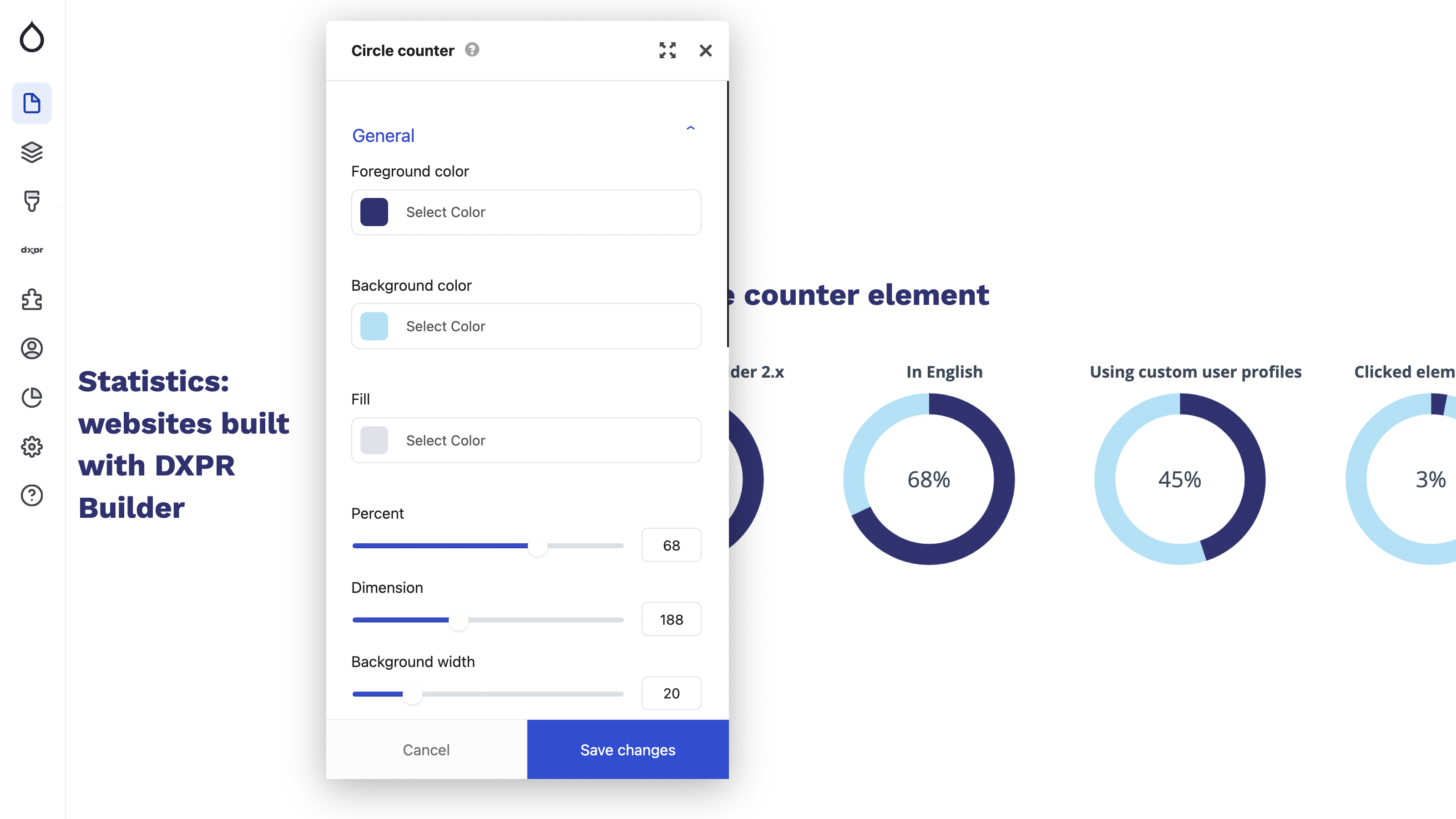
With DXPR Builder, your content is never sent to our servers, it's all rendered inside your browsers. This makes DXPR Builder straightforward when it comes to managing intellectual property, privacy, and compliance. Products like Acquia Site Builder store content on their own servers, which can be a pain to manage with compliance and legal for customers.
Gutenberg for Drupal is also an interesting option, but it's not a page builder. It doesn't provide the elements and layout tools needed to build an entire page. It's suited for content editors who only need to create linear content, not responsive layouts. We don't see Drupal Gutenberg as a competing product.
Finally, I'd like to emphasize that commercial support is an important differentiator of DXPR. We work with large government agencies and fortune 500 companies, and they typically opt to pay extra for enterprise-grade support. Some clients also ask us to build submodules that extend the builder with bespoke drag-and-drop elements that integrate with their other tools. Just the fact that this service exists makes DXPR the right choice for certain types of Drupal users.
TDT [6]: How does DXPR work with Layout builder and the ecosystem of modules available for Drupal?
Jurriaan: Interoperability has always been a priority for us. Contrary to what many developers think, DXPR Builder and core layout builder are actually complementary solutions. We have a YouTube tutorial demonstrating how you can use them together:
The key takeaway is that site builders can use the core layout builder to create a layout for a content type while allowing content editors to use the DXPR Builder to edit the contents of text fields that benefit from our no-code content editing capabilities.
Considering the greater ecosystem, here are some examples of what we did:
- All views displays are made available as drag-and-drop elements.
- We took certain features from the Views admin UI and put them into the DXPR Builder editor to let content editors have (limited) control over views displays.
- Blocks are made available as drag-and-drop elements, with support for block configuration inside DXPR Builder.
- You can create web forms with the webform module, and they can be used as drag-and-drop elements. In the WordPress world, it’s common for drag-and-drop builders to include their own form builder, but we understand this is not the Drupal way.
TDT [7]: Are there any plans to integrate additional features into the layout builder of Drupal or to continue expanding the capabilities of DXPR?
Jurriaan: We recently launched support for Bootstrap 5 and Drupal 10.
Short-term, we’re looking at implementing improved technologies for dragging and dropping, to improve our core functionality, making it even faster and smoother.
We’re also looking to improve capabilities in the area of “composable DXP”. We already support several ways to create reusable components by using templates. We want to invest in improving features and functionality related to composable content authoring. We can make the experience more visual and present our current templating capabilities more prominently in the user experience.

Long term, we are very excited about the capabilities of AI. We’re already using ChatGPT and other tools from OpenAI for code reviews and software development. It’s incredible how these tools can generate and iteratively improve code just like a developer would do.
It’s still early, and the code produced by OpenAI’s tools is too buggy for production use.
We expect AI to be the holy grail for DXPR to achieve our final objective. Think back to the granny tasked with making a webpage about her hobby. Imagine she can just describe what she wants and get a webpage instantly. She could write something like this:
A page about bird photography. I live in Newfoundland, where there are many bird species you don’t see anywhere else. I like to photograph birds by the ocean, in the hills, downtown, and in my backyard. I’ve been shooting with the same analog camera for over 30 years, and I just love the grain it adds to my photos and the rich colors in shadows that you just don’t get with digital. I want a section to be about my camera.
I sell some of my work on canvas for $50 dollars, including shipping, and I want a section on my webpage where people can buy my highlighted works.
I just made this up and I’m going to put it in the OpenAI playground now, preceded only by a prompt to return a full webpage and use the Bootstrap 5 framework. You can see the result here. It’s reasonably close to producing the result I had in mind.
There are many questions surrounding this technology, for example about intellectual property, software licensing, and dependence on a black box you have no control over, etc. I don’t see this happening in 2023, but it’s definitely a space we’re watching.
I hope that in a few years, you can prompt DXPR Builder to create a webpage with exactly the sections and layout you ask for, and it just pops out in a second, saving you time and energy that can now be applied in other areas of your life.
TDT [8]: What challenges have you faced while building and growing DXPR, and how have you overcome them?
Jurriaan: The biggest challenge was building a team. Until 4 years ago, I managed all the responsibilities of maintaining and supporting our products. I hired freelancers to help with tasks, but even with their help, the burden of getting products and services to market was still entirely on me.
It took me a long time to figure out how to build a team that could share all my responsibilities so that I could grow beyond just being a software engineer. This was difficult but also the most rewarding experience.
I took a lot of inspiration from the book “Inspired” by Marty Cagan. It’s a really great book that makes an effort to explain why many businesses fail. It all begins and ends with communication. Not just with clients and potential clients but with all stakeholders. Inspired helped me focus on building a cross-functional product team.
Today we have a strong team that I’m very proud of. We grow together, and the team creates space for me to think big and iterate through product development initiatives that create value for our rapidly digitizing society.

TDT [9]: Can you discuss any specific features or functionality you are proud of within DXPR or have proven to be particularly popular with users?
Jurriaan: Sure, the book I mentioned before also inspired me to invest in product analytics. This means we don’t need to guess what features are successful or unsuccessful, it’s all in the data. Here are 5 popular features that set DXPR Builder apart from other solutions:
- User profiles: Lets you customize the UI and available elements and features per Drupal user role
- Inline text editing
- Live editing: See changes in real-time when interacting with element settings widgets
- Shortcut buttons: For adding a section below another section with 1 click
- User templates: Save any element or combination of elements as a reusable component
When talking about these successes, I think it’s also important to talk about failure. Several years before we implemented product analytics, our “biggest” feature update was our history feature. It’s a component that lets you undo and redo actions and also views and interacts with all history states in a sophisticated way. It was a big investment of software engineering resources for us at the time.
When we got our product analytics running at full speed, it was apparent that the feature was not used much. What we thought was a main selling point was actually a feature that was either not critically important to most of our users and/or we didn’t implement it as well as we should have.
TDT [10]: How do DXPR support SEO and digital marketing efforts, and how does it help users create and optimize their pages for search engines? Is this compatible with Drupal's metatag, schema, and other SEO-related modules?
Jurriaan: Those are 3 questions so let me tackle them one by one:
-
One of the first websites I built with our no-code editor and the low-code theme was a website for my then-girlfriend, a violin player and student at the time. She wanted to rank for the key phrase “vioolles Utrecht” to help her earn money with violin lessons in our city. Using our products, I very quickly set up a website that looked great because it was built within the DXPR design framework. Unlike some competitors’ sites, our site was mobile-responsive out of the box.
There were dozens of sites that were optimized for the same keywords, but due to the sites being owned by small businesses or private persons, they were not designed and developed to the highest standards, and our site out-competed them very quickly. My then-girlfriend got more leads than she could handle and was happy to be able to pick and choose students while her peers struggled to get even one paying student.
The site ranked top 3 within weeks and #1 not much later for the main keyphrase, even though our time investment in the site was very modest.
It is, in a nutshell, how any company, small or large, outperforms its competitors by leveraging the best tools in the business so that its creative talents can focus on what they do best while DXPR takes care of the technical stuff.
This story does not just speak to how our products are technically highly optimized for SEO (which they are). I think it’s more important how the products helped me leverage my time to create more value quickly and get it to market quickly. Our website just looked way better than others and provided well-structured information in layouts that presented the information in a clear, compelling fashion.
Thanks to the no-code capabilities, my then-girlfriend could update and improve the website without my help, despite having no prior experience with editing websites and being someone who “hates computers” (her words). This helped her site stay current, while other sites had outdated content, schedules, and calendars that could scare off potential students.
-
When discussing the capabilities that DXPR Builder and DXPR Theme offer to optimize pages for SEO, the list is not very long, and I’ll elaborate on “why” in point iii;
- Frontend performance: Users love fast and snappy pages. At DXPR we always pay attention to delivering performant and efficient code. Webpages built with DXPR are likely to outperform comparable pages with a similar amount of content and complexity because we follow performance best practices.
- Clean markup: following up on frontend performance, I just wanted to emphasize this point because a lot of no-code builders produce bad HTML markup. Our HTML output is as clean as you can realistically get to hand-coded HTML pages.
- Alt and title attributes on images: Our images have an SEO settings group that lets you set these attributes that are important in SEO.
-
Finally to answer your third question about how DXPR integrates with other Drupal SEO modules: DXPR supports and promotes cross-compatibility within the Drupal ecosystem, and that’s why we don’t have any mind-blowing features in part ii of this answer.
In DXPR Builder, we only provide content editors with SEO features insofar as we think it is needed in a content editor. Do you want to customize metatags? Install the metatag module. Do you want feedback on keyword density and content readability? Install the real-time SEO module. I use both of those modules together with DXPR Builder on DXPR.com, and it works great.
We limit the scope of our product because it’s the Drupal way and because we believe it’s the best way for us to contribute value to the Drupal ecosystem.
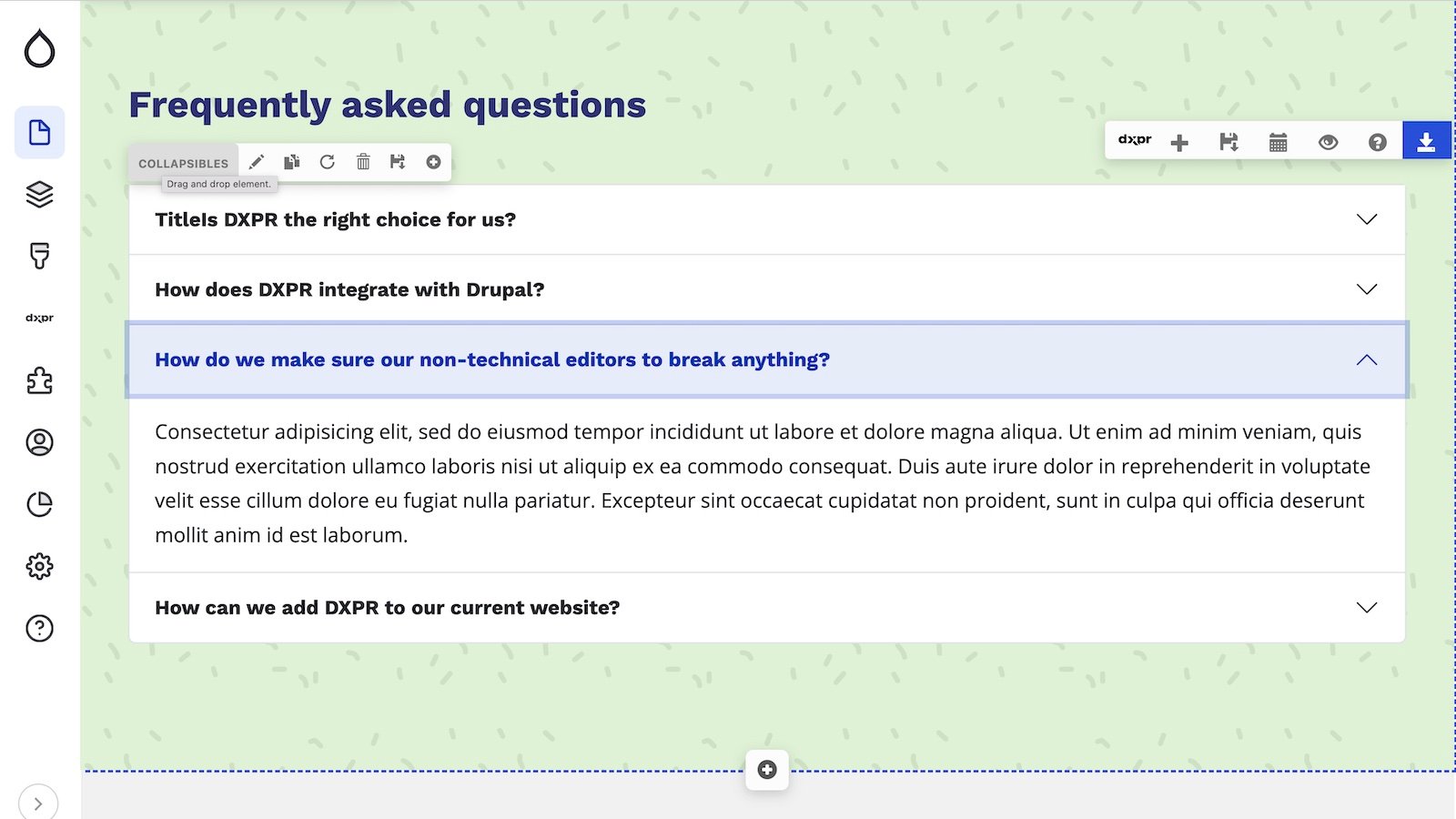
TDT [11]: What happens to the content of the website owner stopping the subscription to DXPR? Is there a migration path available?
Jurriaan: In September, we published our 2.0.0 DXPR Builder release on Drupal.org, whereas previously, we only released DXPR Builder on our private composer server. We did this as part of an initiative to address this question specifically. The initiative introduced the following changes to DXPR:
- We no longer sell DXPR Builder “the module,” but we sell DXPR Builder “the no-code editing experience.” When you stop your DXPR subscription, you keep the module but lose access to the no-code editing experience. All your content will keep working, and you can still edit it using another editor like CKEditor or by editing the HTML code.
- We introduced a monthly billing option.
- DXPR Builder is completely free for an unlimited time but with the limitation (in the free tier) of having 20 drag-and-drop pages per website.
- We open-sourced the module’s backend code and published it on Drupal.org.
You can always stop your paid subscription without breaking your website. All content generated by DXPR Builder is HTML code. There are no proprietary shortcodes or anything like that.
In summary, when you stop your subscription, you will be just fine, you will not lose content, and your website’s visitors will not notice anything. You can restart the subscription for one month when you occasionally need to edit your website, or you can edit the HTML with CKeditor or a code editor.
We just launched a more affordable pricing tier for the occasion that makes commercial support available to a much wider audience. Our new Growth tier is designed to meet the needs of growing businesses, and we're excited to offer this option to the Drupal community.
You can find more information about this tier on our website at https://dxpr.com/pricing.
TDT [12]: Can you discuss any plans or goals for DXPR, including any new features or expansions you are currently working on or considering?
Jurriaan:
Core UX
We are currently researching how to improve our core technology, including our drag-and-drop experience and our controls that let you interact with the elements on the page.
We look at comparable products and see that no solution is perfect and none of the solutions out there are a great fit for our specific target market. We are looking to simplify the experience of composing and editing webpages with a great number of drag-and-drop elements. Based on user feedback and analytics, it is clear that this should be our next area of focus.
Templates UX
We will build on this refreshed drag-and-drop experience by putting templates more prominently in the user experience. There is a clear need for larger clients, especially to create their own component library within DXPR Builder, and that could be our focus after refreshing the core drag-and-drop experience.
I have to add a disclaimer here: because we follow agile best practices, I can’t promise this will be our next initiative. After each sprint, we re-evaluate our priorities based on the newest information and act accordingly.

TDT [13]: How has the COVID-19 pandemic impacted the use and demand for DXPR? How has the company adapted to these challenges?
Jurriaan: The pandemic, though it was a tragic event, was a catalyst for products like DXPR Builder. It was critically important for many websites to show on their homepage and other important web pages how the pandemic affected their products and services. We saw a peak in the usage of DXPR Builder because clients needed ad-hoc changes on their pages, often in the form of banners or sections about how COVID affected their services.
Businesses with no-code solutions like DXPR Builder were able to manage this without IT support, whereas other businesses would need to wait on internal or external IT resources to make time for them. (And bill them after!)
Another effect was that businesses that operated their services on-premise had an immediate need for digital transformation, and some of those businesses became DXPR clients. One example is Academic Medical Education, a medical education platform specializing in virology and using Drupal and DXPR to disseminate information about COVID and other medical topics. Another interesting client of ours was BioNTech, the company that leads research into mRNA vaccines (they have since built a new platform on Adobe Experience Manager).
TDT [14]: Can you share success stories from customers who have used DXPR to build their websites and improve their digital marketing efforts?
Jurriaan: For now I’m afraid I’ll have to ask you to look at our clients page on DXPR.com. Creating case studies is high on our todo-list, but it’s hard because it requires us to get consent from customers to publish detailed information about their online infrastructure. Many of our most interesting clients have policies against this type of collaboration.
TDT [15]: WordPress is a popular choice for small and medium-sized businesses, and it has a large user base and a wide range of plugins and themes. Do you think Drupal, with tools like DXPR, has the potential to become more widely adopted in the small and medium-sized business space? What benefits or advantages do you see Drupal and DXPR offering to SMEs? How do you envision these tools helping to increase Drupal's adoption among small and medium-sized businesses?
Jurriaan: This is such a difficult question. I get the impression that many in the Drupal community do not consider WordPress, a competitor to Drupal. The fact that Automattic’s WordPress VIP service entered the “Agile CMS Forrester Wave” chart as a strong performer should wake some people up. Drupal is threatened from below by WordPress and from above by incumbents like Adobe Experience Manager.
At the same time, I see WordPress is threatened from below by cloud software like Wix and Squarespace. For many small businesses, it’s just not worth the hassle to deal with conflicting plugin updates and a poor security track record (referring to the WordPress plugins).
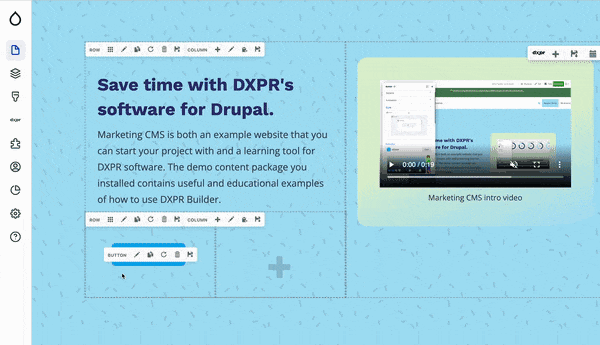
Where does that leave Drupal? I think Drupal is best suited for digital experience projects for larger organizations with more complex requirements. Not for “brochure websites.” However, I do think Drupal 10’s “out of the box UX” initiative is important because it attracts hobbyists to our community who may grow to become important contributors to the Drupal ecosystem.
How does DXPR fit into this picture? One of our most important target markets is those medium-sized companies and enterprises that are not a great fit for Acquia. We provide an alternative that is more accessible, open, and transparent about pricing. Our recently released Marketing CMS is a Drupal 10 distribution that builds onto the “out of the box UX” initiative with next-generation UX solutions that make competitors look dated, not just in the Drupal ecosystem but also in the wider CMS/DXP industry,
TDT [16]: DXPR's proprietary page builder is a key component of the platform and is offered as a subscription-based service. Is there anything that DXPR offers to the larger Drupal community, even for those who do not want to pay a monthly subscription? Are there any resources, tools, or other support that DXPR provides to the Drupal community beyond the page builder subscription?
Jurriaan: I think we should start communicating this better, but you can use DXPR Builder for free with no time limit. With the release of DXPR Builder 2.0.0, we doubled down on our product-led growth strategy and made our product accessible to a larger audience.
We downplayed communication about the free option to avoid being overwhelmed by large amounts new users. We did receive a big influx of new free users, but now that we have some idea of how we can support these users and how many of them convert to paid users we can start promoting our “free tier.”
Beyond DXPR Builder and DXPR Theme, we plan to invest software engineering resources in some of the projects we chose to include in our Marketing CMS Drupal distribution:
- Gin theme / Gin toolbar
- Responsive preview
- Moderation sidebar
- Marketing CMS features, demo content
TDT [17]: How do you see the future of Drupal and the open web movement, and how do you envision DXPR fitting into that?
Jurriaan: Big corporations like Facebook, Google, and Amazon control an increasingly large portion of public information. Our internet is now less free than it used to be, and it is becoming increasingly hard for small communities and businesses to thrive online. I do worry about this and I hope platforms like WordPress and Drupal remain competitive so that we can own our information.
I think this issue is increasingly important because I see a trend of increasing censorship coming from US-based cloud platforms. This censorship is influencing cultural values globally and I don’t like it. While we’re already accustomed to social media platforms completely censoring the uncovered human body, I see even more censorship in the new class of AI cloud platforms like ChatGPT.
To me, this emphasizes the importance of maintaining and improving open-source software like Drupal.

How does DXPR fit into this? Without commercial products like DXPR Builder, Drupal will not remain viable as a platform. The success of Wix is well deserved because they provide a better experience for its users. To achieve this, Wix invests large amounts of capital in product management, UX design, UX research, and product analytics.
The highly skilled people you need to get this right are not the people who benefit most from becoming Drupal contributors, so DXPR’s main value is to invest capital in this area where Drupal core lacks the most. I do think Drupal did great in choosing Sascha to design the Claro theme (and gin ecosystem, which we love), but his contributions, though very welcome, are not enough to make Drupal competitive from a UX perspective.
Disclaimer: The information provided about the interviewee has been gathered from publicly available resources. The responsibility for the responses shared in the interview solely rests with the featured individual.
Note: The vision of this web portal is to help promote news and stories around the Drupal community and promote and celebrate the people and organizations in the community. We strive to create and distribute our content based on these content policy. If you see any omission/variation on this please let us know in the comments below and we will try to address the issue as best we can.











